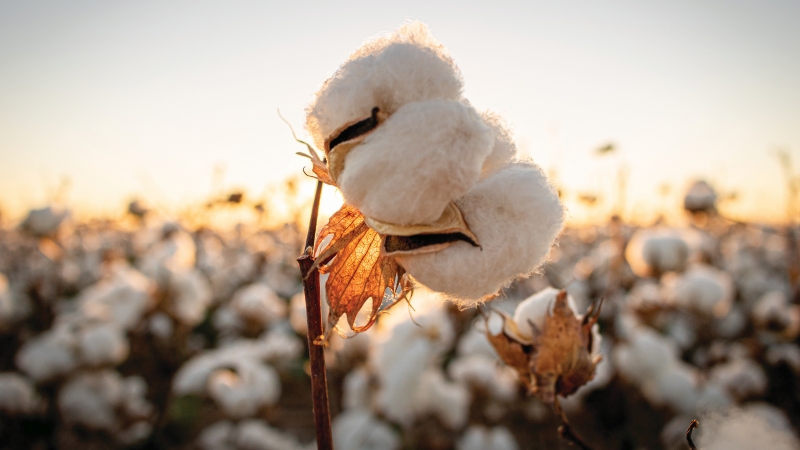Michael Brooks Named 2015 Marketer of the Year
Michael Brooks celebrates the Marketer of the Year award with his son, Brandon (right) and Jarral Neeper (left), Calcot president.
From Cotton Grower Magazine – February 2016
Most people might not consider Michael Brooks a patient man. After all, the fourth generation cotton farmer from Goodyear, AZ, seems perpetually busy. And, by his own admission, a bit brash.
But when it comes to marketing his cotton, he’s more than willing to take his time and accept any advantages the market may offer.
That patience – and a lot of old-fashioned business moxie – earned Brooks the 2015 Marketer of the Year award, presented by ICE Futures during the Beltwide Cotton Conferences in New Orleans in early January.
Brooks started farming in 1975 with his father, Bruce, on land that his great-grandfather homesteaded in 1894. At one time, the family farming operation – now known as MK Farms – covered nearly 15,000 acres of cotton, alfalfa, wheat, barley, sorghum and corn. He was one of the largest cotton growers in the area for three consecutive years in the early 2000’s, but the entire operation has scaled back over the past few years to roughly 5,000 total acres – 1,200 of it in cotton in 2015.
He joined Calcot in 1976 to handle his cotton marketing. Forty years later, he’s still with Calcot, including extensive service as a member of the cooperative’s Board of Directors. Their advice over the years led Brooks to the marketing honor.
“My dad taught me that if you could pencil in a profit and cover your expenses, you could gamble on the rest,” says Brooks. “I may be getting this award now, but we started marketing this cotton three years ago. I’m in Calcot’s spot fixation program, plus we have some cotton in their seasonal pool. We were generally 25% in the spot program and 75% in the seasonal pool. In the last few years, we’ve flipped those ratios to put more emphasis on the spot fixation.”
Calcot’s spot fixation program has two price components – futures and basis. Growers in the program have the option to market those components separately, allowing them to sell futures in advance of fixing the basis, similar to a call contract. That flexibility allowed Brooks to sell 2015 December futures at 80 cents three years ago without worrying about basis.
“What really works well is if you don’t lose beneficial interest until you call your basis,” explains Paul Bush, Calcot vice president and one of Brooks’ advisors. “It also provides a little more management of the LDP component, since the basis isn’t fixed yet.
“Not only did Michael sell futures at 80 cents, we fixed basis on some of his cotton, and he was able to get an LDP,” says Bush. “He did everything the program allowed him to do.”
Brooks also took advantage of a Calcot option that allows a grower to buy back his cotton one time. When the cotton he sold at 80 cents dropped into the 60s, he de-fixed his original contract price, pocketed the equity and had the cotton available to sell again.
“We got a little rally and were able to pick up two to three cents on it,” recalls Brooks. “We thought we were going to make more on it, but it was better than losing it.”
Brooks keeps up with the markets through the Calcot app on his smartphone. “You can see the direction things are going. And, when the reports come out, it’s probably time to do the opposite of what those reports say,” he laughs.
Bush lauds Brooks’ approach to marketing.
“The good growers that are marketers put an X on the wall,” he says. “They may look back and wish they had done something else, but they did it for whatever their reasons were at the time. Michael is that way. He may kick himself sometimes and say ‘I wish I’d done something different,’ but he puts the X on the wall and sticks to it.”
Today, Brooks is focused on the challenges of farming around a rapidly growing urban area and in getting his son, Brandon, totally integrated into the farm operation. He’s thrilled to have a fifth generation ready to continue the family tradition.
“He came in five years ago, and took to farming like a fish to water,” said Brooks proudly. “He started out working 300 acres and is now up to about 2,500 acres. I get a lot of compliments on him.”
Likewise, Brooks’ wife, Margie, keeps the financial side of the farm in order, deftly handling the extra paperwork involved to satisfy environmental requirements in Arizona.
And, the logistics – and expense – of farming amidst urban encroachment present their own set of challenges.
“I farm from Laveen to Buckeye,” said Brooks. “It’s 34 miles from our farthest field to the gin, and we have to drive through town for most of that distance. Our biggest section of the farm has between 600 and 700 acres, and our smallest is about three acres. I used to farm everything contiguous from Goodyear to Buckeye, but a lot of those acres were lost to housing and warehousing.”
Brooks shows no signs of slowing down. In addition to his Calcot service, he serves as secretary/treasurer of Arizona Cotton Growers Association, vice president of Farmers Gin, and is a member of Arizona Farm Bureau. And though he also pays close attention to his other crops – and dabbles in the cattle business as a “hobby” – there’s no question about where his heart lies.
“I’m a cotton farmer through and through,” he says. “I lived through 28 cent cotton less than 12 years ago. If we made it through that, we can sure make it through 66 cents.”










